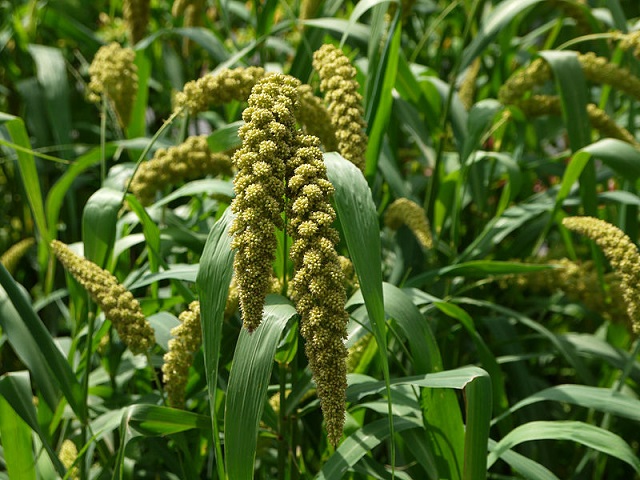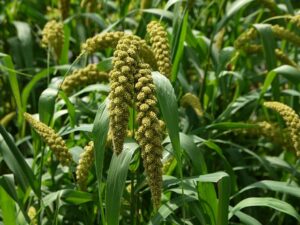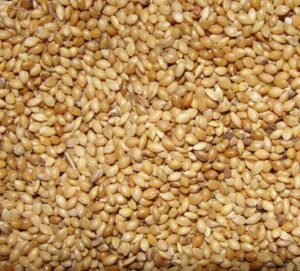Cultivation Kakun or Foxtail Millet in India
Cultivation Kakun or Foxtail Millet in India
Kakun or Italian Millet (Setaria italica (L.) Beauv.) belongs to the family Poaceae. It is an annual plant with slender and erect stems. It grows to a height of 90-150 centimeters.
Nutritive Value of Kakun or Foxtail Millet ;
|
Component |
Values |
Component |
Values |
|
Protein |
12.3 g |
Magnesium |
81 mg |
|
Carbohydrates |
60.1 g |
Sodium |
4 mg |
|
Fiber |
6.7 g |
Calcium |
31 mg |
|
Fat |
4.3 g |
Iron |
2.8 mg |
|
Calories |
331 Kcal |
Niacin |
3.2 µg |
|
Phosphorus |
188 g |
Folic Acid |
15 µg |
Health Benefits of Kakun or Foxtail Millet:
2) It improves the functioning of the Nervous System:
3) Kakun helps in Weight loss
4) It is useful in controlling Diabetes
5) It helps in maintaining Strong Bones
7) It is good for the Skin.
8) Helps in good Digestion
9) Good for Celiac Patients
Climatic Requirements for Kakun or Foxtail Millet;
1) Kakun is cultivated in tropical as well as temperate regions.
Soil for Kakun or Foxtail Millet cultivation ;
Kakun should be grown on fairly fertile soil for good yields, although it can grow in poor soils. Light soils like red loams, alluvials, and black cotton soils are all suitable for its cultivation but it thrives best on rich, well-drained loam soils
Important Varieties of Kakun or Foxtail
There are several improved varieties of Kakun suitable for growing in different states. some of the improved varieties are ;
|
State |
Varieties released/ recommended |
Varieties popular in the State |
|
A.P. |
Krishna devaraya and Pant Setaria-4. |
– |
|
Chhattisgarh |
Pant setaria-4. |
– |
|
Karnataka |
Pant setaria-4 and HMT-100-1 |
SIA-326, PS-4 and TNAU-186. |
|
MP |
Pant Setaria-4. |
– |
|
Maharashtra |
Pant Setaria-4. |
– |
|
Orissa |
Pant Setaria-4. |
– |
|
Tamilnadu |
TNAU-43 and CO (Te)-7. |
K-2, K-3, CO-4, CO-5, CO-6 and CO (Te)-7. |
|
UP |
Pant setaria-4 |
– |
|
West Bengal |
Pant setaria-4 |
– |
Rotations and Mixed Cropping Kakun or Foxtail Millet cultivation ;
Generally, it is sown as a mixed crop with cotton, maize, arhar, and black gram, but sometimes it is raised as a pure crop. When it is sown as a pure crop the following crop rotations are followed:
Kakun-linseed
Field Preparation for Kakun or Foxtail Millet cultivation ;
1) Kakun does not require much field preparation.
Seed and Sowing for Kakun or Foxtail Millet cultivation
1) An early crop of kakun is sown in May
1) The crop is generally sown in rows at a 25-30 centimeter distance.
Manures and Fertilisers Requirement for Kakun or Foxtail Millet Cultivation;
1)The crop is usually manured with 5 to 10 tonnes of farmyard manure per hectare.
Water Management in Kakun or Foxtail Millet Cultivation;
1) Kakun sown during Kharif season does not require any irrigation.
Weed Control in Kakun or Foxtail Millet Cultivation;
It is recommended to control the weeds in the initial stage of plant growth. Two to three weedings with hand hoe are sufficient to keep the weeds in control.
Diseases and Pest Management Kakun or Foxtail Millet Cultivation;
Disease ;
1) Kernel Smut
This is caused by the fungus Ustilago crameri. Affected plants usually are stunted. The affected earheads are full of black masses. The caryopsis is replaced by the dark spore mass. The floral bracts often break to release the spores as the plant approaches maturity.
2) Downy Mildew
This is caused by a fungus, Sclerospora graminicola. Diseased plants are dwarfed with excessive development of tillers. Lengthwise yellow-green streaks are seen on the leaves. In severe infection, chlorotic local lesions develop on the leaves. Later on, leaves start drying.
Insect Pests
There is not much problem of insect pests in kakun. Some of the pests which attack kodo may also attack kakun crop. Control measures are similar to kodo crop.
Harvesting and Threshing of Kakun or Foxtail Millet ;
The crop flowers in 50-60 days and matures in 80-100 days. The crop is harvested when the earheads are dry, either by cutting the whole plant by sickle or the cars separately. After drying for few days, threshing is done with a stone roller or by trampling under the feet of bullocks.
The yield of Kakun or Foxtail Millet ;
The yield of the rainfed crop ranges from 600-1000 kg grain and 1000 to 2000 kg straw per hectare.





After exploring a handful of the blog articles on your web site,
I really like your technique of blogging. I added it to my bookmark site list
and will be checking back soon. Take a look at my web site as well and
let me know what you think.